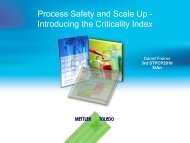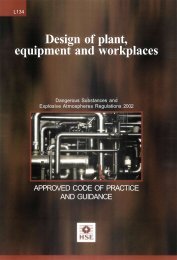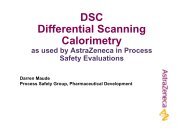Designing and operating safe chemical reaction processes HSG143
Designing and operating safe chemical reaction processes HSG143
Designing and operating safe chemical reaction processes HSG143
Create successful ePaper yourself
Turn your PDF publications into a flip-book with our unique Google optimized e-Paper software.
Health <strong>and</strong> SafetyExecutiveDecomposition: The breaking up of a <strong>chemical</strong> compound into gaseous products.The temperature at which decomposition occurs depends on scale <strong>and</strong> is markedlydependent on the sensitivity of the measuring equipment.Deflagration: Chemical <strong>reaction</strong> propagating through a material by a <strong>reaction</strong> frontor zone travelling at subsonic speed.Detonate: see Detonation.Detonation: Chemical <strong>reaction</strong> propagating through a material by a <strong>reaction</strong> frontor zone in front of a shock wave travelling at supersonic speed.Dewar: A vacuum flask that can be used in calorimetry.DIERS: The Design Institute for Emergency Relief Systems of the AmericanInstitute of Chemical Engineers. A collaborative group of companies <strong>and</strong>organisations.Differential scanning calorimetry (DSC): A technique in which the difference ofenergy inputs into a substance <strong>and</strong> a reference material is measured as a functionof temperature while the substance <strong>and</strong> reference material are subjected to acontrolled temperature program. DSC <strong>and</strong> DTA are essentially equivalent.Differential thermal analysis (DTA): see differential scanning calorimetry.DSC: see differential scanning calorimetry.DTA: see differential thermal analysis.Dumping: Rapid discharge of the contents from the bottom of a reactor. Termsometimes used synonymously with ‘bottom venting’.Endothermic: A <strong>reaction</strong> is called endothermic if energy (heat) is absorbed duringthe <strong>reaction</strong>.Exothermic: A <strong>reaction</strong> is called exothermic if energy (heat) is released during the<strong>reaction</strong>.Explosion: A release of energy sufficient to cause a pressure wave.Flow regime: An idealised model of the behaviour of a two-phase system thatbest describes the actual behaviour.Foamy: see foamy flow.Foamy flow: A flow regime in which the vapour <strong>and</strong> liquid phases are uniformly<strong>and</strong> homogeneously mixed as a foam.Gassy systems: A system type for relief system sizing in which pressureincrease is due to permanent gas generated by a <strong>reaction</strong>.Hazard: The disposition of a thing, a condition or a situation to cause injury. The‘injury’ of concern is physical injury <strong>and</strong>/or ill health to people, though this may beaccompanied by harm to property <strong>and</strong> the environment.Hazard <strong>and</strong> operability study (HAZOP): A technique to identify process hazards<strong>and</strong> potential <strong>operating</strong> problems using a series of guide words to study processdeviations.<strong>Designing</strong> <strong>and</strong> <strong>operating</strong> <strong>safe</strong> <strong>chemical</strong> <strong>reaction</strong> <strong>processes</strong> Page 61 of 64










